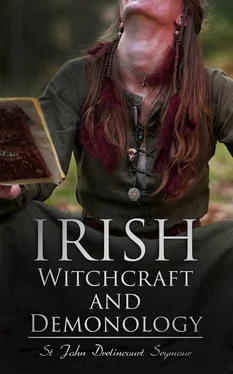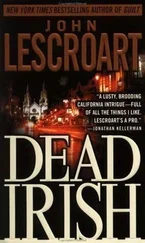Sir Arnold le Poer, who had taken such a prominent part in the affair, was next attacked. The Bishop accused him of heresy, had him excommunicated, and committed prisoner to Dublin Castle. His innocency was believed in by most people, and Roger Outlawe, Prior of Kilmainham, who also figures in our story, and who was appointed Justiciary of Ireland in 1328, showed him some kindness, and treated him with humanity. This so enraged the Bishop that he actually accused the Justiciary of heresy. A select committee of clerics vindicated the orthodoxy of the latter, upon which he prepared a sumptuous banquet for his defenders. Le Poer died in prison the same year, 1331, before the matter was finally settled, and as he was under ban of excommunication his body lay unburied for a long period.
But ultimately the tables were turned with a vengeance. De Ledrede was himself accused of heresy by his Metropolitan, Alexander de Bicknor, upon which he appealed to the Holy See, and set out in person for Avignon. He endured a long exile from his diocese, suffered much hardship, and had his temporalities seized by the Crown as well. In 1339 he recovered the royal favour, but ten years later further accusations were brought to the king against him, in consequence of which the temporalities were a second time taken up, and other severe measures were threatened. However, by 1356 the storm had blown over; he terminated a lengthy and disturbed episcopate in 1360, and was buried in the chancel of S. Canice’s on the north side of the high altar. A recumbent effigy under an ogee-headed canopy is supposed to mark the last resting-place of this turbulent prelate.
In the foregoing pages we have only given the barest outline of the story, except that the portions relative to the practice of sorcery have been fully dealt with as pertinent to the purpose of this book, as well as on account of the importance of the case in the annals of Irish witchcraft. The story of Dame Alice Kyteler and Bishop de Ledrede occupies forty pages of the Camden Society’s publications, while additional illustrative matter can be obtained from external sources; indeed, if all the scattered material were gathered together and carefully sifted it would be sufficient to make a short but interesting biography of that prelate, and would throw considerable light on the relations between Church and State in Ireland in the fourteenth century. With regard to the tale it is difficult to know what view should be taken of it. Possibly Dame Alice and her associates actually tried to practise magical arts, and if so, considering the period at which it occurred, we certainly cannot blame the Bishop for taking the steps he did. On the other hand, to judge from the analogy of Continental witchcraft, it is to be feared that De Ledrede was to some extent swayed by such baser motives as greed of gain and desire for revenge. He also seems to have been tyrannical, overbearing, and dictatorial; according to him the attitude adopted by the Church should never be questioned by the State, but this view was not shared by his opponents. Though our sympathies do not lie altogether with him, yet to give him his due it must be said that he was as ready to be persecuted as to persecute; he did not hesitate to face an opposition which consisted of some of the highest in the land, nor did fear of attack or imprisonment (which he actually suffered) avail to turn him aside from following the course he had mapped out for himself.
It should be noticed that the appointment of De Ledrede to the See of Ossory almost synchronised with the elevation of John XXII to the Papacy. The attitude of that Pope towards magical arts was no uncertain one. He believed himself to be surrounded by enemies who were ever making attempts on his life by modelling images of him in wax, to be subsequently thrust through with pins and melted, no doubt; or by sending him a devil enclosed in a ring, or in various other ways. Consequently in several Bulls he anathematised sorcerers, denounced their ill-deeds, excited the inquisitors against them, and so gave ecclesiastical authorisation to the reality of the belief in magical forces. Indeed, the general expressions used in the Bull Super illius specula might be applied to the actions of Dame Alice and her party. He says of certain persons that “they sacrifice to demons and adore them, making or causing to be made images, rings, &c., with which they draw the evil spirits by their magical art, obtain responses from them, and demand their help in performing their evil designs.”7
Heresy and sorcery were now identified, and the punishment for the former was the same as that for the latter, viz. burning at the stake and confiscation of property. The attitude of this Pontiff evidently found a sympathiser in Bishop de Ledrede, who deemed it necessary to follow the example set by the Head of the Church, with what results we have already shown: thus we find in Ireland a ripple of the wave that swept over Europe at this period.
It is very probable, too, that there were many underlying local causes of which we can know little or nothing; the discontent and anger of the disinherited children at the loss of the wealth of which Dame Alice had bereft them by her exercise of “undue influence” over her husbands, family quarrels, private hatreds, and possibly national jealousy helped to bring about one of the strangest series of events in the chequered history of Ireland.
Конец ознакомительного фрагмента.
Текст предоставлен ООО «ЛитРес».
Прочитайте эту книгу целиком, купив полную легальную версию на ЛитРес.
Безопасно оплатить книгу можно банковской картой Visa, MasterCard, Maestro, со счета мобильного телефона, с платежного терминала, в салоне МТС или Связной, через PayPal, WebMoney, Яндекс.Деньги, QIWI Кошелек, бонусными картами или другим удобным Вам способом.












